The man who solved the atom’s mysteries
Ernest Rutherford showed the way to how the world works.
Ernest Rutherford and the Birth of Modern Physics, by Matthew Wright.
Ernest Rutherford showed the way to how the world works.
Ernest Rutherford and the Birth of Modern Physics, by Matthew Wright.
The pendulum in the writing and teaching of New Zealand history appears to have swung back from what has been called the binary view of a morality play. This depicted a struggle between good and evil, with the former being subdued and victimised innocents and the latter being imperialist oppressors.
It was best expressed in a proposed history curriculum for schools and was widely debated in educational circles a few years ago. It seems that has now become more nuanced and reflected in at least one recent rewriting of New Zealand’s early history, Eric Olssen’s The Origins of an Experimental Society, New Zealand 1769-1860.
This volume of some 400 pages plus another 120 of notes and sources (a whopping 2640 of them) is a lifetime’s work for Olssen, a former professor of history at the University of Otago. It has two more volumes to go and should supplant the previous iterations from Keith Sinclair, Michael King, and James Belich as core reading.
I fear, however, that Olssen has overdone the scholarship and will not gain the readership the others did with their more popular versions.
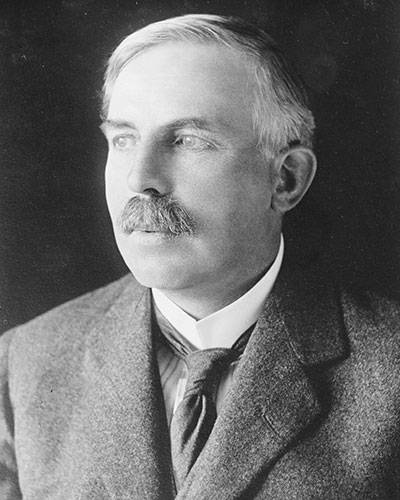
Ernest Rutherford in 1910. Source: Library of Congress.
That does not detract from Olssen’s primary aim of putting New Zealand’s colonial experience at the forefront of the modern world’s evolution into prosperous democratic societies based on ideas born in 18th-century Europe.
Far from being a backwater at the ends of the Earth, New Zealand and its British Empire equivalents in Australia and North America were among the quickest to exploit and benefit from 19th-century advances in science and technology.
This is best illustrated in the story of Ernest Rutherford, who was educated to college and university level in Nelson and Christchurch. He had access to the latest developments in Europe and North America but was constrained only by the lack of engagement with those at the higher end of the field.
This was an era of rapid advances in chemistry and physics that created the modern world. When Rutherford was born in 1871, three decades after Nelson’s settlement, it was an urban Victorian town with the latest trappings of civilisation being adopted as fast as they could be paid for.
Historian Matthew Wright explodes the myth of Rutherford and his generation as raw pioneers living off the land. In his new biography, Ernest Rutherford and the Birth of Modern Physics, Wright emphasises how Rutherford’s upbringing, though rural because his father was a flax and sawmiller, reflected the social outlook of British middle-class city-dwellers.
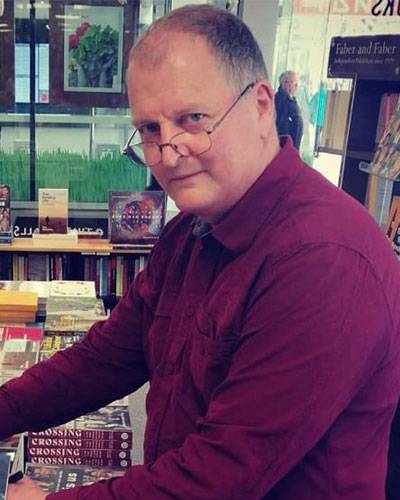
Matthew Wright.
“This was matched by a soaring vision in which New Zealand was going to become a bigger and better Britain in the South Pacific,” Wright writes.
In the 1860s, during the gold rushes and high demand for wool, New Zealand was part of an expanding Pacific Rim economy servicing North America and Australia through trade and facilities such as banking.
By the time Rutherford was 10, 40% of the population lived in urban areas, where social views on women’s rights and living standards were ahead of the rest of the world. During the years when Rutherford was studying at Canterbury University College, Christchurch had steam-driven trams, a modern sewer system, and street lighting.
Before he travelled to England on a scholarship in 1895, Rutherford was already known for his experiments in electrodynamics. He slipped easily into the class-conscious English society after being accepted into the Cavendish Laboratory at the University of Cambridge.
His ambition and drive were applied to work on radio waves, X-rays, and particle physics. One experiment led to the invention of a smoke detector, the first of many discoveries that could be attributed to Rutherford and his colleagues.
Encouraged by Cavendish’s director, ‘JJ’ Thompson, Rutherford was soon on an upward trajectory of the academic ladder, first to McGill University in Montréal, Canada, in 1898.
The scientific world and the public imagination were obsessed with radioactivity and the work of Pierre and Marie Curie in Paris. In a competition with them, Rutherford had two goals: a Fellowship of the Royal Society and a Nobel Prize.
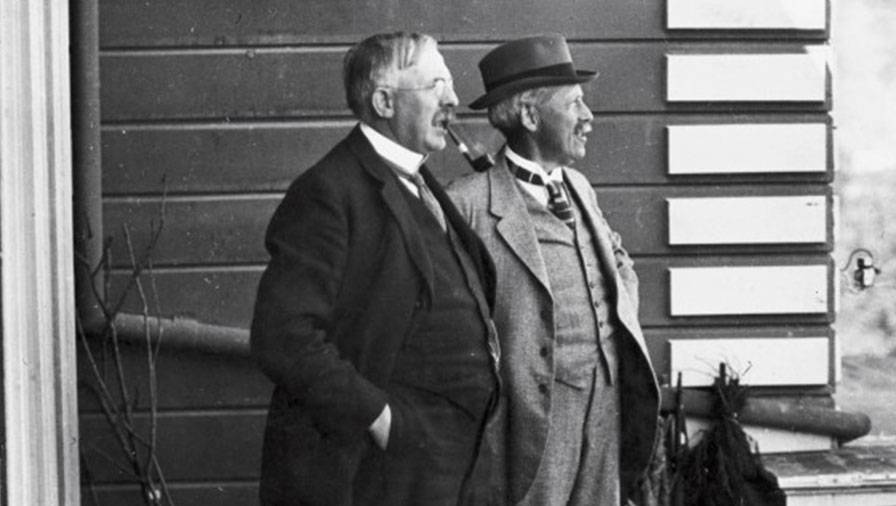
Cavendish Laboratory directors Ernest Rutherford and JJ Thomson in the 1930s.
On a trip to New Zealand in 1900, he let slip to a reporter the scoop that radioactivity contained huge amounts of energy and that particles in his experiments indicated this came from inside atoms.
It was the first reported mention of what could result from splitting the atom and wasn’t made scientifically known until papers in 1903 and 1904. The ambitious Rutherford was soon frustrated that Canada’s remoteness from the centre of action in Europe was holding back his two goals.
He cleverly used Nature magazine to foreshadow discoveries that were later published in detail. He also learnt German to spread his ideas to a country where Albert Einstein and Max Planck were creating quantum mechanics.
Rutherford’s explanation of radioactivity as atomic disintegration and the Germans’ work on relativity overturned the basics of physics and sent the world of scientific discovery in a new direction.
Wright provides the big picture as well as the minutiae in every step through the first three decades of the 20th century, when physics redefined how the world worked.
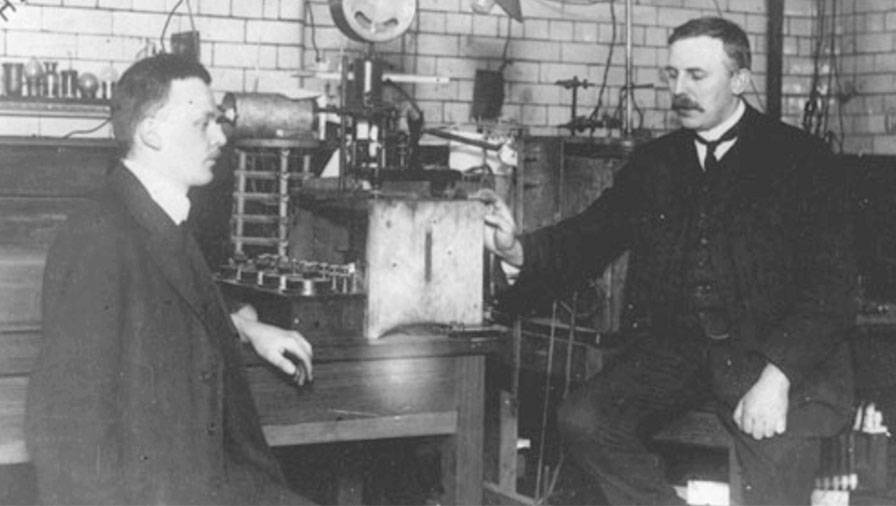
Hans Geiger and Ernest Rutherford in their laboratory at Manchester, 1912.
It was the culmination of a Western culture that had built the “complex societies and technology” that made advanced science possible. Rutherford was among those who had become household names.
He had left McGill after a decade to head the physics laboratory at Victoria University of Manchester, where he recruited Hans Geiger to lead experiments in particles. Rutherford’s first Nobel Prize, for chemistry, arrived in 1908 and a knighthood in 1914 (followed by a peerage in 1931). The Nobel money, worth the equivalent of about $1.6 million today, was spent on a four-seater Wolseley. He had been admitted to the Royal Society and elected president in 1925.
World War I interrupted Geiger’s work on the structure of atoms. Rutherford was put to work on submarine detection, opening a new world of sonics and ultrasound, still in use today.
When Thompson retired from Cavendish in 1919, he was replaced by Rutherford. Atomic research had become a large-scale industrial activity, and Cavendish was the world leader.
Its work by a new generation of scientists became Rutherford’s legacy, just as Einstein and Planck found their early development of quantum mechanics was superseded or confirmed by Niels Bohr (another Rutherford prodigy), Werner Heisenberg, and others.
The electrodynamic revolution of the 1890s that had launched Rutherford’s career had led him to solve the mystery of radioactivity, discover the nuclear structure of atoms, and create the science of particle physics.
His sudden death in 1937 aged 66 generated tributes from around the world, not least from New Zealand, where he was praised as possibly the greatest of the nation’s sons. That was certainly the case until Edmund Hillary’s mountaineering efforts in 1953.
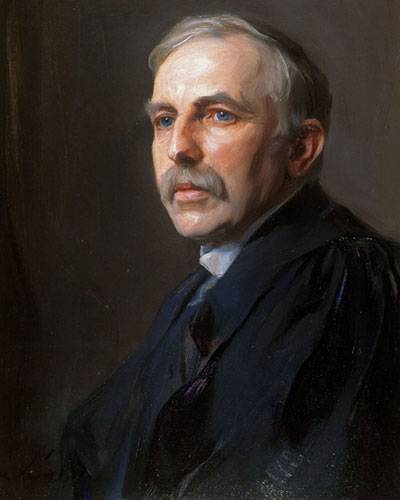
Philip de László’s portrait of Rutherford
at Trinity College, Cambridge.
Wright’s extensive scholarship into Rutherford’s papers and personality presents a man of conservative tastes and a literal-mindedness that pushed him into hands-on experiments.
Unlike the stereotypical physicist, he was gregarious and extroverted, but with an impatience that reflected his desire for answers. Wright goes further, with a discussion of Rutherford’s thinking processes that favoured the abstract, and made it difficult for him to explain his ideas.
Suggestions that he had a mild form of dyslexia led to misconceptions that he was a “plodder, competent but uninspired, getting results by hard work”. This could explain his early struggles with exams and interviews.
But, in Wright’s view, this masked his “extraordinary genius, his ability to conceive of a problem and to seize on a piece of evidence that others did not…”
This is not the first full-scale biography of Rutherford, but it is one informed by knowledge of recent developments in physics. It adds substantially to Andrew Ramsey’s The Basis of Everything (2019), a joint biography of Rutherford and his younger Australian collaborator, Marcus Oliphant.
Wright's list of 60 previous books is heavy on New Zealand’s military engagements, engineering achievements, and the science behind earthquakes. His latest is distinguished by having two editions, one for an international audience. The two are identical except for the local one being printed in China and the other in Australia.
Ernest Rutherford and the Birth of Modern Physics, by Matthew Wright (Oratia Books (NZ) and Scribe Publications (Australia)).
Nevil Gibson is a former editor at large for NBR
Sign up to get the latest stories and insights delivered to your inbox – free, every day.